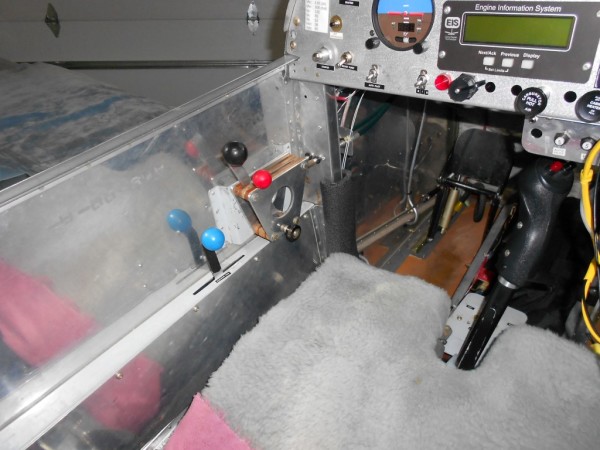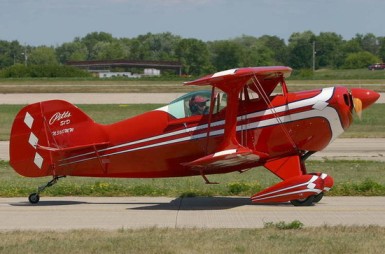I have a friend who is building a Thatcher CX-4. He had been working on his elevator trim installation and had put the trim control on the right side of the aircraft and the throttle on the left. This triggered some thoughts that other builders may find useful so I figured I would document them here.
The following is a photo of my throttle quadrant and trim on my Vans RV-3B.
As you can see, all the controls are on the left side of the cockpit, all are manipulated with the left hand.
The quadrant looks to be positioned a bit high on the cockpit wall but it is actually positioned such that ones hand/arm fall on it naturally. Additionally, the trim is positioned so that it can be adjusted with the “heel” of my hand. This is really beneficial as it allows trim adjustments without removing ones hand from the throttle.
During typical cross country flight, none of this matters much. It does matter when things get interesting. In the military world, the term used for this is HOTAS, an abbreviation for “Hands On Throttle-And-Stick”, and is the concept of placing controls right on the throttle and flight control stick. This allows you to access vital functions without having to remove your hands from the flight controls. Additionally, this allows quick and easy access the controls without having to look for them, this helps you remain focused on more important duties. The goal is to improve situational awareness, your ability to manipulate switch and button controls in turbulence, under stress, or during high G-force maneuvers, to improve reaction time, to minimize instances when you must remove your hands from the controls, and total time spent doing so. Obviously, we don’t have a dozen (or more) functions on our controls – weapon select, target select, arm, chaff, flairs, etc… But, I think we should learn from the lessons that the military has learned.
I’ve been doing a lot of formation flying which is pretty high stress and long periods of time when you do not want to take your hands off the flight controls. The ability to keep my hand on the stick at all times and easily adjust throttle, mixture, and trim without moving my left hand off the throttle quadrant is a really good thing.
Obviously, formation flying is not the only time this is of value though. Those tight approaches into a back country airstrip when your attention is required outside not looking around the cockpit for the trim or mixture control and a go around when you need mixture and trim changes (right now!) are both examples.
My point (finally!) to all of this is to encourage those of you that are still building to locate your controls in a similar fashion to achieve as many of the benefits listed above as possible. It really does make a difference.




I see in your arrangement it is unlikely to happen but some tactile means (dimpled knob?) to distinguish throttle and trim may be useful when the two controls are of similar configuration and in close proximity. I almost lost a friend last year when he was getting checked out in a Citabria. The throttle and trim levers are on the same quadrant on the particular example he was flying. While practicing landings and just short of the numbers the instructor in the back seat called for go-around power, Jim had his hand on what he thought was the throttle but turned out to be the trim. He pushed it full forward and the plane nosed in from about 50 ft. Multiple broken bones, one week coma, serious facial reconstruction and six months rehab ensued.